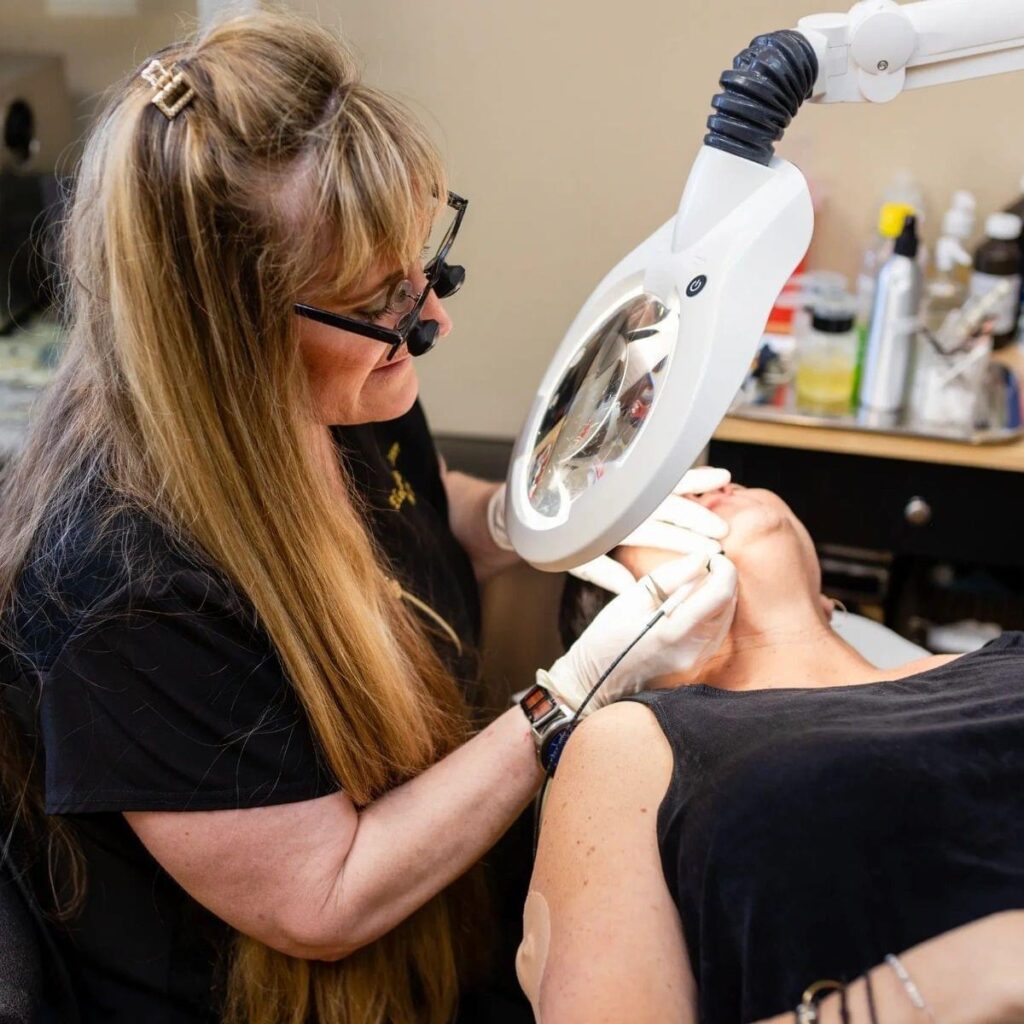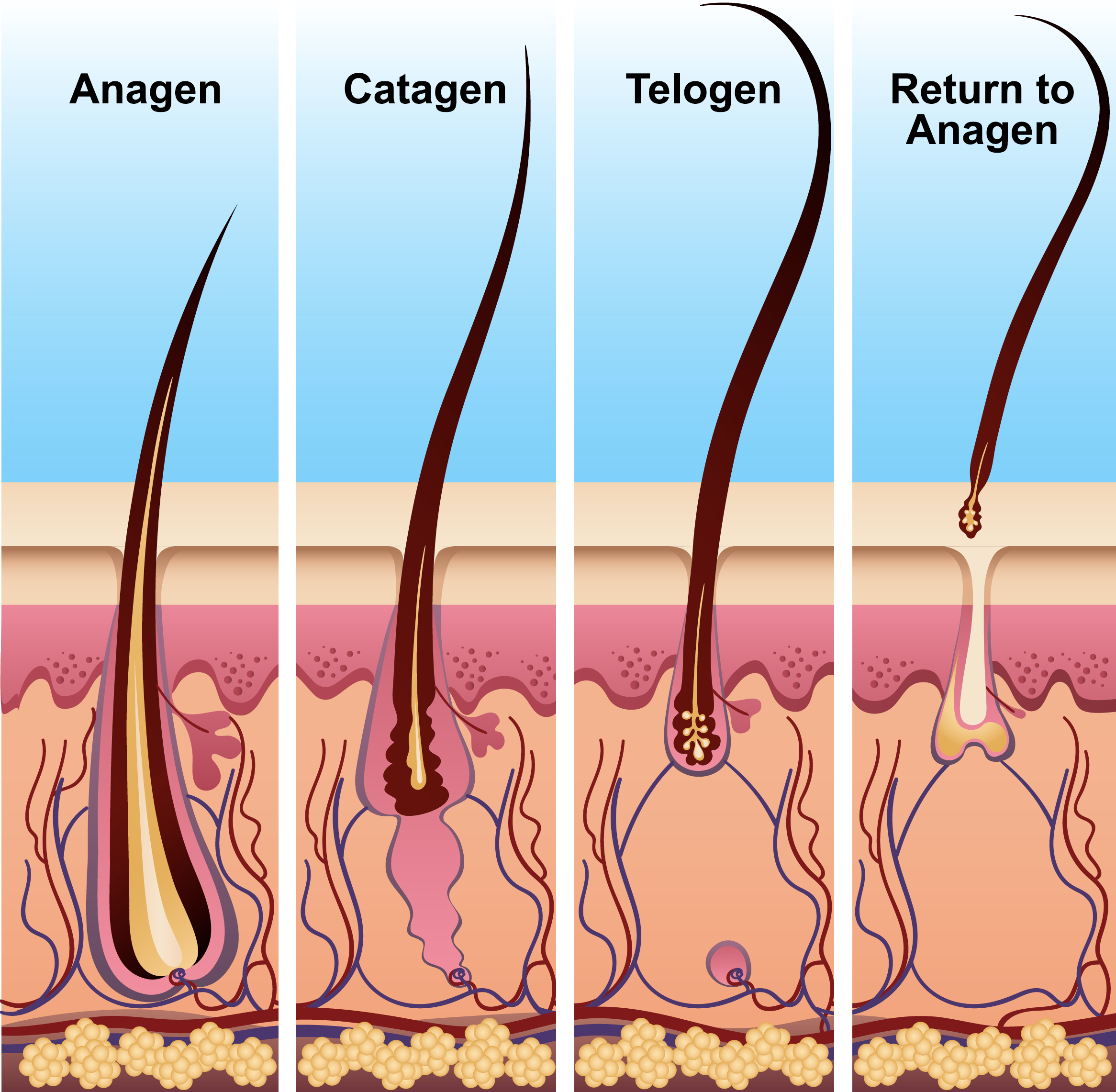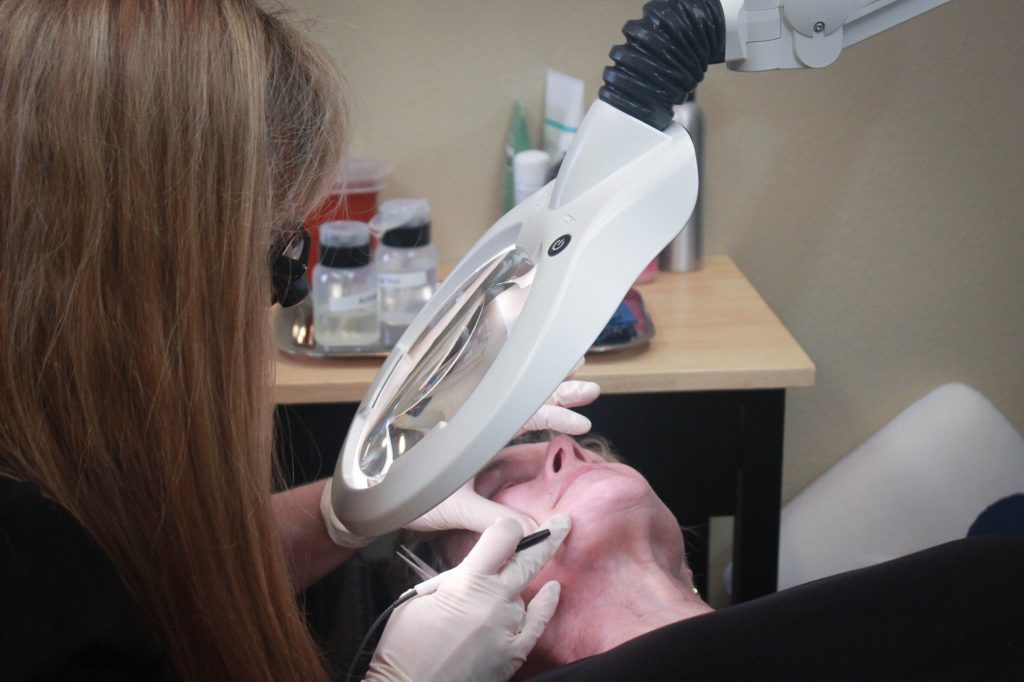Electrolysis is a method of removing individual hairs permanently from the face or body. A very fine metallic probe is inserted along the hair shaft into the hair follicle. It damages the hair follicle using electricity to disable hair production. Though a time-consuming, delicate procedure, it will work on any type or color of hair in any location and is the only method that permanently removes light-colored hair such as red, grey, and pale blonde.
Electrolysis is better suited for sparse hairs or small areas. For larger areas or dense hair patches, electrolysis requires multiple visits to treat each hair even one time. Whether the hairs are being treated with electrolysis or laser, most hairs require multiple visits to permanently damage the follicle enough to prevent future hair growth.


To understand how electrolysis works you first must understand a little bit more about the anatomy and physiology of hair and how it grows.
Hair growth has three stages.
Stage 1
The Anagen stage of hair growth is when the hair is in its prime state to be treated. During the anagen stage, the root is attached to the papilla (blood supply responsible for hair growth).
Stage 2
The Catagen stage is when the root detaches itself from the papilla and the hair begins to move up the follicle wall. The lower portion of the follicle collapses which makes it more difficult to reach the papilla, and kill the germinating cells.
Stage 3
The Telogen stage is when the hair detaches from the base and stops growing. It is retained in the skin until it eventually sheds. Once the hair falls out on its own, the hair may be dormant for a couple of weeks to about 4 months. It may also begin producing a hair right away. It is not possible to successfully treat a hair in this stage with electrolysis or laser.

Goal of Electrolysis
For successful electrolysis, the goal is to treat the hair while it is in the earliest part of the Anagen stage. Since all of your hairs will be in different stages of growth at any given time, it is important to come in and have hairs removed when you first see them.
The idea is to keep treating the visible hairs in order to continue to damage the follicle to prevent hairs from growing. It is important to remember that every person has varying growth cycles due to hormone changes and other factors that stimulate the blood flow to the hair.
The pain threshold is different from person to person. However, there are things one can do to make a huge difference in pain tolerance.
Following these guidelines will help.

The removal of superfluous hair by electrolytic action of galvanic current had its beginning in 1875 when Charles E. Michel, M.D., of St. Louis, Missouri, discovered he was able to remove ingrown eyelashes by the simple process of inserting a needle charged with a negative galvanic current into the hair follicle. At first, it was thought that the follicle was “electrocuted” but later it was determined that the process was one of chemical decomposition produced by electrolytic action. Therefore, the removal of hair with electricity came to be called “electrolysis.”

No. Hair follicles are resilient and will grow back, usually finer and thinner, but they require multiple treatments in order to kill germinating cells and to permanently disable the follicle.
Yes! All areas of the body can be treated. The most common areas are the chin, lip, and eyebrows. Other areas include, but are not limited to, the bikini, underarms, stomach, breast, ears, and legs.
The area treated will be slightly red and sometimes slightly swollen. For most people, the redness lasts only a few hours or less. The amount of irritation you experience will depend on the number of coarse hairs and the density of the area.
This is dependent on each individual and the hairs’ growth cycle. For example, if you are tweezing daily, you may want to come in once a week. It is best to consult your electrologist for the best treatment plan based on your hair growth cycles. The important thing is to maintain a consistent treatment plan.
Hair growth is the result of multiple factors: Heredity, hormone levels (including puberty and menopause), some drugs, temporary methods of hair removal (including waxing and tweezing), illnesses, and hormone replacement therapy.
The area to be treated must be clean and free of makeup. For further instructions, please see Before & After Care for Electrolysis
Please refer to our Before & After Care for Electrolysis sheet.

Call us today for a free consultation so we can help improve your appearance and confidence in a relaxed private environment.
CERAMIC FACES MADE BY LANI. *Results not typical.
One of the major questions that constantly comes up is “Why is laser referred to as ‘permanent hair reduction’ and electrolysis referred to as ‘the only permanent hair removal method’?“
When hair removal lasers were first introduced, the FDA approved them for permanent hair removal. Later, it was discovered that lasers were not capable of treating every color of hair. They work on brown and black hair, but not red, white, grey, or blonde hair. Since most people have combinations of different hair colors, the FDA now requires laser treatments to claim only “permanent hair reduction.”
It is important to remember that both electrolysis (which treats all color of hair) and laser (which only treats brown or black hair) effectively removes the visible hairs permanently, unless there is an underlying hormone or medical cause of hair growth which would continually stimulate new growth (e.g., PCOS and hormone replacement therapy) .
